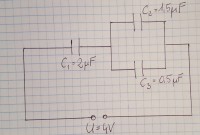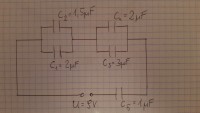Hello, how to calculate the load ( $$ Q_{2}$$ ) on a capacitor with a capacity $$C_{2}$$ ? (capacitor layout in the appendix)
I am trying to use the formula here: $$Q=UC$$
I substitute the data from the drawing for this formula.
$$Q_{2}=4 \cdot 1,5=6$$ however, this is not a valid result.
Thank you in advance for your help :)
I am trying to use the formula here: $$Q=UC$$
I substitute the data from the drawing for this formula.
$$Q_{2}=4 \cdot 1,5=6$$ however, this is not a valid result.
Thank you in advance for your help :)




